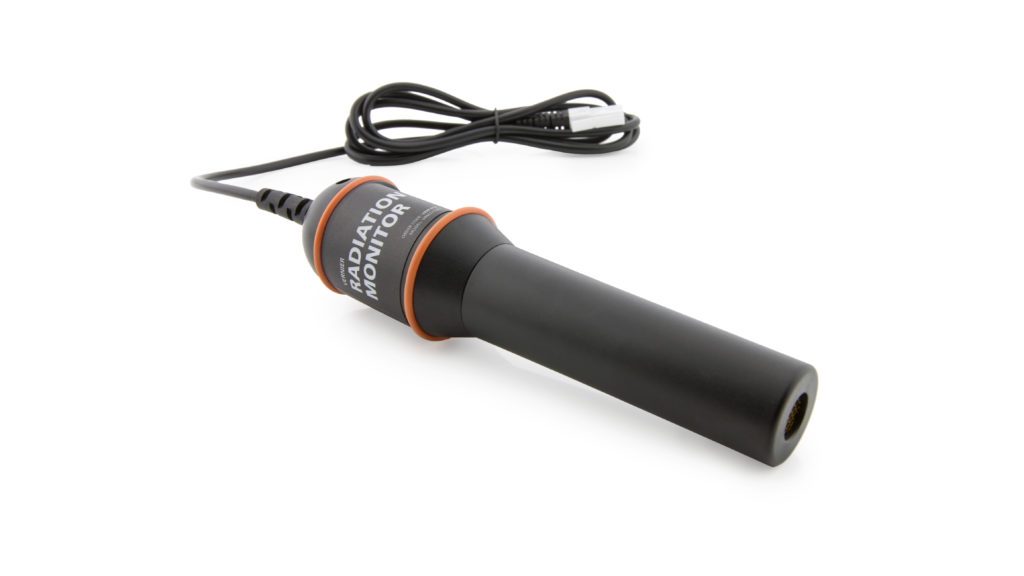Vernier Radiation Monitor User Manual
Order Code: VRM-BTD
The Vernier Radiation Monitor is used to monitor alpha, beta, and gamma radiation. It can be used with a number of interfaces to measure the total number of counts per specified timing interval.
Use this sensor to
- Detect the presence of a source of radiation.
- Monitor counts/interval (rate) as different thicknesses of a particular type of shielding are placed between the Geiger-Mueller tube of the Radiation Monitor and a beta or gamma source.
- Compare the effect of different types of materials to shield beta or gamma radiation.
- Set up a histogram with a very long run time to show students how initial randomness of data develops first in a Poisson distribution, and then into a Gaussian distribution curve.
- Measure radiation of common radioactive materials, such as lantern mantels or pre-World War II Fiestaware.
- Monitor variation in background radiation at different elevations.
- Monitor radioactivity in the environment over long periods of time.
- Monitor counts per interval (rate) from a beta or gamma radiation source as a function of the distance between the source and the Radiation Monitor.
Note: Vernier products are designed for educational use. Our products are not designed nor are they recommended for any industrial, medical, or commercial process such as life support, patient diagnosis, control of a manufacturing process, or industrial testing of any kind.
Compatible Software
Choose a platform below to see its compatibility requirements.LabQuest
Interface LabQuest App LabQuest 3 Full support LabQuest 2 Full support LabQuest Full support Computers
Software Interface Graphical Analysis Graphical Analysis (Web App) Logger Pro (discontinued) LabQuest Mini Full support Full support Full support LabQuest 3 Full support Full support Full support LabQuest 2 Full support Full support Full support LabQuest Stream Full support 1 Full support 1 Partial support 2 LabQuest Full support Full support Full support LabPro Incompatible Incompatible Full support 3 Compatibility Notes
Chromebook
Software Interface Graphical Analysis (Web App) LabQuest Mini Full support LabQuest 3 Full support LabQuest 2 Full support LabQuest Stream Full support 1 LabQuest Full support Compatibility Notes
iOS
Software Interface Graphical Analysis Graphical Analysis GW LabQuest Stream Full support Full support LabQuest 3 Full support 1 Full support 1 LabQuest 2 Full support 1 Full support 1 Compatibility Notes
Android
Software Interface Graphical Analysis Graphical Analysis GW LabQuest Stream Full support Incompatible LabQuest 3 Full support 1 Full support 1 LabQuest 2 Full support 1 Full support 1 Compatibility Notes
Arduino
Software Interface Arduino Vernier Arduino® Interface Shield Full support LabVIEW
Software Interface NI LabVIEW SensorDAQ Full support Vernier myDAQ Adapter Full support LabQuest Mini Full support LabQuest Stream Full support LabQuest 3 Full support LabQuest 2 Full support LabQuest Full support Texas Instruments
Software Interface EasyData DataMate DataQuest TI-Nspire Software CBL 2 Full support 1 2 Full support 1 2 3 Incompatible Incompatible LabPro Full support 1 2 Full support 1 2 3 Incompatible Incompatible TI-Nspire Lab Cradle Incompatible Incompatible Full support Full support Compatibility Notes
Quick Start
- Plug the sensor into the interface (LabQuest 3, LabQuest Mini, etc.).
- Connect the interface to your device.
- If using USB, connect to the USB port on your computer.
- If using Bluetooth® wireless technology, click your interface type and then select your device.
- Prepare for data collection:
- Vernier Graphical Analysis®: Launch the app, if necessary, and click Sensor Data Collection.
- LabQuest® App: Choose New from the File menu.
The software will identify the sensor and load a default data-collection setup. You are now ready to collect data.
Need Additional Information?
Visit the following link:
Videos
Specifications
|
Sensor |
LND 712 (or equivalent) halogen-quenched GM tube with a 1.5 to |
|
Gamma sensitivity |
18 cps/mR/hr referenced to Co-60 |
|
Temperature range |
–20 to 50°C |
|
Operating range CPS |
0–3,500 |
Suggested Experiments
Counts/Interval vs. Distance Studies
The data in the two graphs below were collected by monitoring gamma radiation at various distances from a Radiation Monitor. Data were collected with the run intervals set at 100 seconds. After each 100-second interval, the source was moved one centimeter further from the source. Since distance is proportional to time (300 seconds in the first graph corresponds to 3 cm in the second graph;
400 seconds to 4 cm, etc.), a new distance column was made using time divided by 100. The curved fit shown corresponds to distance raised to the –2 power (inverse squared).
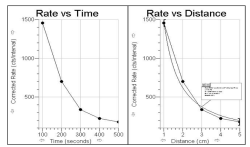
Counts/Interval vs. Shielding Studies
The data shown here were collected by monitoring gamma radiation with an increasing number of pieces of silver foil placed between the source and a Radiation Monitor. Data was collected with the run interval set at 100 seconds. After each 100-second interval, another piece of silver foil was placed between the source and the Radiation Monitor. Since the number of pieces is proportional to time (300 seconds corresponds to 3 pieces of foil, 400 seconds to 4 pieces of foil, etc.), a new column, pieces of silver foil, was made using time divided by 100.
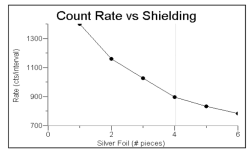
Half-Life Determination (Counts/Interval vs. Time)
Using a daughter isotope generator, it is possible to generate isotopes with a relatively short half-life. A solution that selectively dissolves a short half-life daughter isotope is passed through the generator. The linear plot of natural log of decay rate vs. time can be used to determine the half-life of the daughter isotope, using the formula
where λ is the decay rate constant and t½ is the half-life of the daughter isotope (in minutes).
In the plot of natural log of decay rate vs. time, the decay rate constant, λ, is equal to –m. Using the slope value of m = –0.217 in the example here, the
half-life was calculated to be 3.19 minutes.
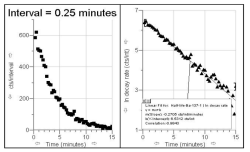
Histogram Data Analysis
For an easy in-class experiment, set up a histogram with a very long run time and start data collection. Whenever the graph overflows the top of the graph, it will be rescaled. This data collection shows students how initial randomness of data develops into a Gaussian distribution. A gamma radiation source was used.
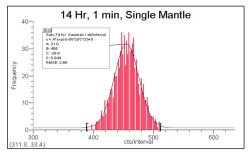
Lantern Mantles
This graph shows a study of old and new Coleman mantle lanterns. These mantles formerly contained thorium and were often used for radiation demonstrations. In the early 1990s, Coleman changed the production methods and now the mantles are not radioactive. First, no mantle was near the monitor for ten minutes, then an old mantle for ten minutes, and then a new, non-radioactive mantle for the last ten minutes.
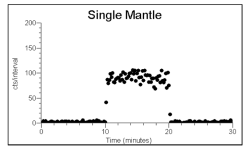
Background Radiation
Here is an experiment performed in the days before airlines insisted that you turn off your personal computer before takeoff. It shows the counts/interval between takeoff and the time the plane reached its cruising altitude of 39,000 ft.
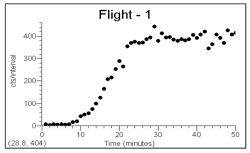
Curricular Materials
Nuclear Radiation with Vernier
by John Gastineau
This book has six experiments written for the Vernier Radiation Monitor. Each of the six experiments has a computer version (for LabPro, LabQuest, or LabQuest Mini), a calculator version (for LabPro or CBL 2™), and a LabQuest version (for LabQuest 3, LabQuest 2, or the original LabQuest as a standalone device). The electronic resources for Nuclear Radiation with Vernier contain the word-processing files for all student experiments.
Radioactive Sources
If you do not have radiation sources, you may be able to obtain pre-1990 Coleman lantern mantles or other brands of lantern mantles (for a weak source of Thorium). You may also be able to find pottery, watches, clocks, or minerals that are moderately radioactive. Vaseline glass and red-orange Fiestaware plates made prior to 1943 can be found in antique stores.
For something more active, order radioactive minerals from these scientific supply houses. The
2.5 cm disk sources of alpha, beta and gamma radiation are particularly convenient.
|
Flinn Scientific Inc. P.O. Box 219 Batavia, IL 60510 Phone (800) 452-1261 |
Spectrum Techniques 106 Union Valley Road Oak Ridge, TN 37830 Phone (865) 482-9937 |
Care and Maintenance
Do not insert anything through the screen at the tip of the sensor. The surface is very fragile.
Do not wrap the cable tightly around the sensor for storage. Repeatedly doing so can irreparably damage the wires and is not covered under warranty.
How the Sensor Works
The Radiation Monitor senses ionizing radiation by means of a Geiger-Mueller (GM) tube. The tube is fully enclosed inside the instrument. When ionizing radiation or a particle strikes the tube, it is sensed electronically and monitored by a computer and by a flashing count light. There is an optional audio signal. Radiation is measured in counts in a time interval, as configured in data-collection software. About 5 to 25 counts at random intervals (depending on location and altitude) can be expected every minute from naturally occurring background radiation. The flashing count light will always flash when an event is detected. To enable or disable the audio signal, use the switch on the side of the unit.
The end of the GM tube has a thin mica window. This mica window is protected by the screen at the end of the sensor. It allows alpha particles to reach the GM tube and be detected. The mica window will also sense low energy beta particles and gamma radiation that cannot penetrate the plastic case or the side of the tube. Note: Some very low energy radiation cannot be detected through the mica window. The tube is fragile and physical damage to the window is not covered by the warranty.
Note: Since the software must count pulses for one data-collection interval before reporting a value, a reading will never be shown at t = 0.
Further Tips for Monitoring Radiation
To measure gamma and X-rays, hold the tip of the Radiation Monitor toward the source of radiation. Low-energy gamma radiation (10–40 KeV) cannot penetrate the side of the GM tube, but may be detected through the end window.
To detect alpha radiation, position the monitor so the suspected source of radiation is next to the GM window. Alpha radiation will not travel far through air, so put the source as close as possible (within 1/4 inch) to the screen without touching it. Even a humid day can limit the already short distance an alpha particle can travel.
To detect beta radiation, point the end window toward the source of radiation. Beta radiation has a longer range through air than alpha particles, but can usually be shielded (e.g., by a few millimeters of aluminum). High energy beta particles may be monitored through the back of the case.
To determine whether radiation is alpha, beta, or gamma, hold the tip of the monitor toward the specimen. If there is an indication of radioactivity, it is most likely gamma or high energy beta. Place a piece of aluminum about 3 mm (1/8") thick between the case and the specimen. If the indication stops, the radiation is most likely beta. (To some degree, most common radioactive isotopes emit both beta and gamma radiation.) If there is no indication through the back of the case, position the end window close to, but not touching, the specimen. If there is an indication, it is probably alpha or beta. If a sheet of paper is placed between the window, and the indication stops, the radiation is most likely alpha. In order to avoid particles falling into the instrument, do not hold the specimen directly above the end window.
The Radiation Monitor does not detect neutron, microwave, radio frequency (RF), laser, infrared, or ultraviolet radiation. Some isotopes it will detect relatively well are cesium-137, cobalt-60, technicium-99m, phosphorus-32, and strontium-90.
Some types of radiation are very difficult or impossible for this GM tube to detect. Beta emissions from tritium are too weak to detect using the Radiation Monitor. Americium-241, used in some smoke detectors, can overexcite the GM tube and give an indication of a higher level of radiation than is actually there.
Troubleshooting
For troubleshooting and FAQs, see www.vernier.com/til/3207
Repair Information
If you have watched the related product video(s), followed the troubleshooting steps, and are still having trouble with your Radiation Monitor, contact Vernier Technical Support at support@vernier.com or call 888-837-6437. Support specialists will work with you to determine if the unit needs to be sent in for repair. At that time, a Return Merchandise Authorization (RMA) number will be issued and instructions will be communicated on how to return the unit for repair.
Warranty
This product is warranted to the original owner to be free from defects in materials and workmanship for five years from the date of purchase. The Geiger-Mueller tube is covered by a one-year warranty.
Vernier will, at its own discretion, repair or replace this instrument if it fails to operate properly within this warranty period unless the warranty has been voided by any of the following circumstances: misuse, abuse, or neglect of this instrument voids this warranty; modification or repair of this instrument by anyone other than Vernier voids this warranty; contamination of this instrument with radioactive materials voids this warranty. Contaminated instruments will not be accepted for servicing at our repair facility.
The GM tube has a finite life span, and it is normal that it must be replaced after a few years, although some tubes last much longer. Tubes that fail within a year of purchase will be replaced under warranty. Tubes that fail after a year will be replaced for a fixed fee of $89. The GM tube is fragile and physical damage to the entrance window is not covered by warranty. Tubes that are punctured will not be replaced under warranty. The user is responsible for determining the suitability of this product for his or her intended application.
The user assumes all risk and liability connected with such use. Vernier is not responsible for incidental or consequential damages arising from the use of this instrument.
Disposal
When disposing of this electronic product, do not treat it as household waste. Its disposal is subject to regulations that vary by country and region. This item should be given to an applicable collection point for the recycling of electrical and electronic equipment. By ensuring that this product is disposed of correctly, you help prevent potential negative consequences on human health or on the environment. The recycling of materials will help to conserve natural resources. For more detailed information about recycling this product, contact your local city office or your disposal service.
 The symbol, shown here, indicates that this product must not be disposed of in a standard waste container.
The symbol, shown here, indicates that this product must not be disposed of in a standard waste container.
Contact Support
Fill out our online support form or call us toll-free at 1-888-837-6437.

